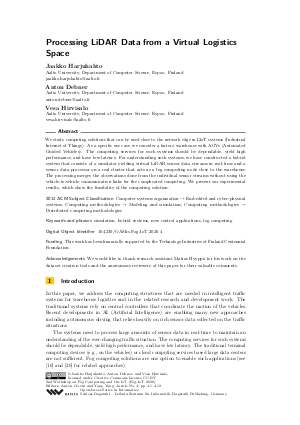@InProceedings{harjuhahto_et_al:OASIcs.Fog-IoT.2020.4,
author = {Harjuhahto, Jaakko and Debner, Anton and Hirvisalo, Vesa},
title = {{Processing LiDAR Data from a Virtual Logistics Space}},
booktitle = {2nd Workshop on Fog Computing and the IoT (Fog-IoT 2020)},
pages = {4:1--4:12},
series = {Open Access Series in Informatics (OASIcs)},
ISBN = {978-3-95977-144-3},
ISSN = {2190-6807},
year = {2020},
volume = {80},
editor = {Cervin, Anton and Yang, Yang},
publisher = {Schloss Dagstuhl -- Leibniz-Zentrum f{\"u}r Informatik},
address = {Dagstuhl, Germany},
URL = {https://drops.dagstuhl.de/entities/document/10.4230/OASIcs.Fog-IoT.2020.4},
URN = {urn:nbn:de:0030-drops-119985},
doi = {10.4230/OASIcs.Fog-IoT.2020.4},
annote = {Keywords: simulation, hybrid systems, new control applications, fog computing}
}

 Creative Commons Attribution 3.0 Unported license
Creative Commons Attribution 3.0 Unported license




